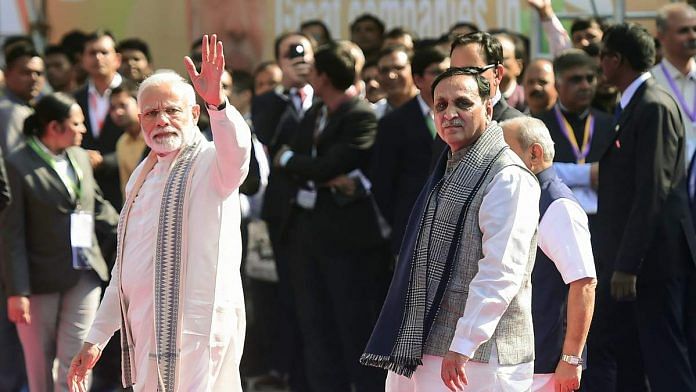Summits like Vibrant Gujarat, inaugurated by PM Narendra Modi Thursday, are pitched as events meant to highlight the host sites as investment destinations.
New Delhi: Vibrant Gujarat, the big-ticket biennial investment summit whose ninth edition was inaugurated Thursday by Prime Minister Narendra Modi, seems to have lost its sheen and brand value over the years as India continues to struggle with a rise in unemployment.
Vibrant Gujarat, the brainchild of Modi during his stint as chief minister, is increasingly seen by many as a political networking platform that does little to help as the country continues to grapple with a jobless slow growth.
The summit was launched in 2003, when Gujarat was taking baby steps into globalisation and seeking greater foreign investments even as it rode India’s trajectory of growth, which was then clocking in at over 8 per cent.
While a number of memorandums of understanding (MoUs) get signed during the events, rarely do they fructify in actual investments, as MoUs do not have any legal obligation.
For example, at the last edition of the summit, as many as 25,578 MoUs were signed, but the state government never came out with the exact investment amount international investors committed to.
Gujarat chief secretary J.N. Singh recently stated that about 65 per cent of the MoUs signed since 2003 had seen fruition. However, there is no credible government data to substantiate these claims.
“There is always a gap behind a promise and delivery,” Mahesh Vyas, the CEO of Centre for Monitoring Indian Economy (CMIE), an independent think-tank, told ThePrint. “Events like Vibrant Gujarat are engineered by the government and also steered by the government. There is always a greater desire to beat their own targets and hence the number of MoUs goes higher and higher, while it loses touch with reality,” he added.
Vyas said the MoUs signed and investments promised each year are greater in value than “the MoUs signed for the entire country put together”.
Meanwhile, the cost to the exchequer for organising such shows remains huge. Last year, Gujarat Chief Minister Vijay Rupani informed the assembly that the state had altogether spent Rs 150.91 crore on organising ‘Vibrant Gujarat’ summits in 2015 and 2017.
Even then, their appeal for the wider world seems to be waning. The UK refused to be a partner country for the 2019 Vibrant Gujarat summit, reportedly over the “lack of satisfactory commercial outcomes” in previous engagements, while the US pulled out over the country’s trade disputes with India.
Only the respective business councils of the countries have brought their delegations for the summit, and that is more to understand the investment climate of India than exploring investment opportunities.
Also read: Modi’s quota bill is just a band-aid solution and doesn’t promise more jobs
Other mega trade and investment shows
Similar versions of the summit are also hosted by states like Rajasthan, Uttar Pradesh, West Bengal, Jharkhand and Odisha to project the states as viable investment destinations, but there is no credible data to suggest that such shows attract either investors or meaningful employment.
Mega trade shows like Vibrant Gujarat, Resurgent Rajasthan, UP Investors Summit and the Bengal Global Summit, among others, have failed to push India’s stagnant manufacturing growth, which plummeted to 7.9 per cent in the financial year 2016-17 from 10.8 per cent the previous year, according to official data.
Today, India is struggling with a slackening growth rate of around 7 per cent, which is compounded by a rising unemployment rate.
According to the CMIE, the number of people who got jobs in 2017-18 stood at 397 million, which is 10.9 million less than the figure for the previous financial year, 407.9 million.
In May last year, the government had cited an International Labour Organisation (ILO) report in Parliament to say that unemployment in India was expected to rise from 18.3 million in 2017 to 18.6 million in 2018 and 18.9 million in 2019.
“These mega shows only cater to the present dispensation. The countries may have pulled out because there is uncertainty on the political scenario of the country,” said former finance secretary Arvind Mayaram. “Investors seek a stable political environment with proper law and order,” he added. “We can also see right now there is a rapid deceleration in gross investment rate, which fell from 38 per cent of the GDP in 2011 to 27 per cent of the GDP now.”
Ajay Shankar, the former secretary at the Department of Industrial Policy and Promotion (DIPP) in the Ministry of Commerce and Industry, said: “Gone are the days when India needed roadshows or mega trade shows to showcase its potential as an investment destination.”
“Countries are well aware of India now and keep a close watch on the political and business developments,” he added. “What is required today is creation of a conducive business environment and well-meaning jobs.”
Also read: Modi pushes upper caste quota ahead of Lok Sabha polls, but where are the jobs?







haha ab bongali batyenge invesment or job creation kaise hota hai, CPI aur momta begum ki policy to dikh hi rahi hai adha bengal durse state me naukri karne ja raha hai..
Manufacturing grew by 0.5% in November. Sometimes a single statistic provides a reality check.